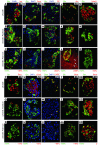Embryonic endocrine pancreas and mature beta cells acquire alpha and PP cell phenotypes upon Arx misexpression
- PMID: 17404619
- PMCID: PMC1839241
- DOI: 10.1172/JCI29115
Embryonic endocrine pancreas and mature beta cells acquire alpha and PP cell phenotypes upon Arx misexpression
Abstract
Aristaless-related homeobox (Arx) was recently demonstrated to be involved in pancreatic alpha cell fate specification while simultaneously repressing the beta and delta cell lineages. To establish whether Arx is not only necessary, but also sufficient to instruct the alpha cell fate in endocrine progenitors, we used a gain-of-function approach to generate mice conditionally misexpressing this factor. Mice with forced Arx expression in the embryonic pancreas or in developing islet cells developed a dramatic hyperglycemia and eventually died. Further analysis demonstrated a drastic loss of beta and delta cells. Concurrently, a remarkable increase in the number of cells displaying alpha cell or, strikingly, pancreatic polypeptide (PP) cell features was observed. Notably, the ectopic expression of Arx induced in embryonic or adult beta cells led to a loss of the beta cell phenotype and a concomitant increase in a number of cells with alpha or PP cell characteristics. Combining quantitative real-time PCR and lineage-tracing experiments, we demonstrate that, in adult mice, the misexpression of Arx, rather than its overexpression, promotes a conversion of beta cells into glucagon- or PP-producing cells in vivo. These results provide important insights into the complex mechanisms underlying proper pancreatic endocrine cell allocation and cell identity acquisition.
Figures





Comment in
- J Clin Invest. 117:971.
References
-
- Adrian T.E., Bloom S.R., Hermansen K., Iversen J. Pancreatic polypeptide, glucagon and insulin secretion from the isolated perfused canine pancreas. Diabetologia. 1978;14:413–417. - PubMed
-
- Csaba Z., Dournaud P. Cellular biology of somatostatin receptors. Neuropeptides. 2001;35:1–23. - PubMed
-
- Roncoroni L., Violi V., Montanari M., Muri M. Effect of somatostatin on exocrine pancreas evaluated on a total external pancreatic fistula of neoplastic origin. Am. J. Gastroenterol. 1983;78:425–428. - PubMed
-
- Heller R.S., et al. Genetic determinants of pancreatic epsilon-cell development. Dev. Biol. 2005;286:217–224. - PubMed
-
- Wierup N., Svensson H., Mulder H., Sundler F. The ghrelin cell: a novel developmentally regulated islet cell in the human pancreas. Regul. Pept. 2002;107:63–69. - PubMed
Publication types
MeSH terms
Substances
Grants and funding
LinkOut - more resources
Full Text Sources
Other Literature Sources
Molecular Biology Databases
Research Materials
Miscellaneous

